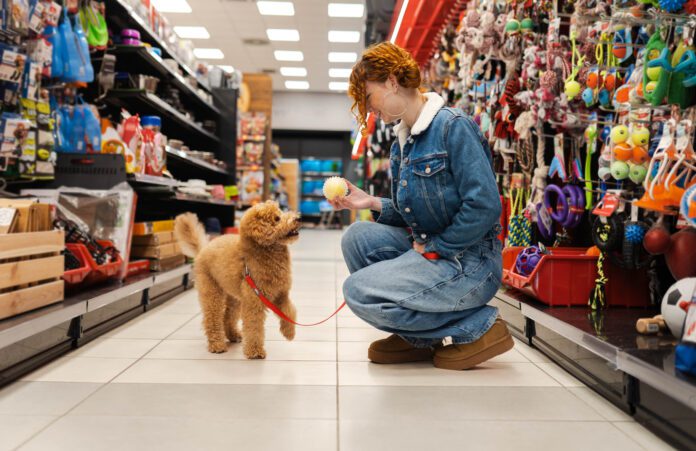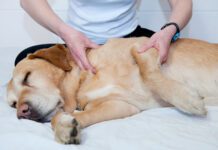What comes to mind when you think of things you need for your dog? (Not necessarily things you want: much as I might like a diamond-encrusted collar or a $1,000 plush dog bed for Frankie, they’re not really necessities. Not in my world, anyway.) When it comes right down to it, pretty much everyone has a different idea of what items are considered essential for a dog.
So how do you figure out what your new pet really needs? Let’s narrow it down to what most pet experts feel are genuine essentials: that is, things that you simply cannot do without if you’re going to have a dog in your life.
Food, Water, and Dog Dishes
It goes without saying that food is number one (and for your dog, treats are next in line) on the list of essentials for your dog. But that begs the question: what kind of food? The answers range from dry kibble to canned to frozen and frozen raw to freeze-dried to air-dried to homemade. Every dog’s needs are different, and every dog caretaker’s schedules and budgets are different as well. There’s simply no one-size-fits-all.
Whether it’s a commercially prepared food or one made at home, you want the highest-quality food (or ingredients) you can afford. If you’re buying a commercial food, start by looking for this statement on the label from the Association of American Feed Control Officials: “formulated to meet the nutritional levels established by the AAFCO Dog Food Nutrient Profiles,” which guarantees that the product is, in fact, complete and balanced. This statement also indicates what life stage the food is intended for: growth, maintenance, gestation/lactation, or all life stages.
While dogs can certainly thrive on properly formulated home-cooked diets, those two words are key: “properly formulated.” It can be a challenge to prepare a nutritionally complete and balanced diet in quantities suitable for home feeding. Avoid choosing a random recipe from the internet and instead use one that’s formulated by a board-certified veterinary nutritionist. In terms of choosing a commercial food, Whole Dog Journal compiles an annual list of recommended foods made by the companies on our “Approved Foods” list.
Proper hydration is equally critical for your dog’s health, which means making sure he has a source of fresh, clean water at all times. One of the biggest mistakes caretakers make is buying a too-small water dish: it should be at least twice the size of the food bowl—for most dogs that is somewhere between 6 and 10 inches in diameter. And speaking of bowls, research suggests that the size of food bowls is a major influence on the amount of food we give to our dogs, which in turn contributes to the growing problem of pet obesity. Remember to measure your dog’s food before giving it to him. If you’re not sure how much he should be getting or how many meals per day to offer, speak with your veterinarian for recommendations specific to your dog.
Dog Collars, Harnesses, and Leashes
A good collar or harness and a leash are essential in that they give you a way to keep your dog with you and away from potential dangers such as busy roads and wildlife. Many places also have leash laws that require your pet to be on a leash in public. In addition, a collar or harness can carry identification tags that can help get your dog back home to you if he ever gets lost.
It would take far more space than we have here to discuss the myriad collars, harnesses, and leashes on the market today, not to mention listing all their pros and cons. In terms of leashes, your main choice will be length; six feet is a good length for most dogs and normal dog-related activities.
When choosing a dog collar or harness, the most important factors are safety, fit, and function. Making an informed choice involves research so you can learn what the device does, what it’s for, and what’s best for your particular dog.
Dog Toys
Unless your dog is one of those rare ducks that doesn’t like or know how to play with toys (like my previous dog Joey, who literally turned up his nose at every toy, ball, or plaything I tried to entice him with), a portion of your annual dog-budget will likely go toward toys. Toys are essential for dogs in that they help provide the mental stimulation necessary to keep a dog healthy, happy, and away from less desirable behaviors.
There are thousands, if not millions, of dog toys on the market, but many contain materials that make them unsafe or even toxic. Some are hard plastic that can break apart and cause physical injury or a choking hazard, some contain fiber matrix materials that can trigger blockages and other internal damage if ingested, others are edible chew toys that can produce disorders of the digestive tract such as diarrhea, vomiting, and bowel obstruction. Studies have shown that toys made of natural rubber not only avoid these hazards, but because rubber is naturally flexible and resistant to dogs’ teeth, it’s far safer than plastic and silicone.
You definitely want to avoid toys with small parts that your dog could chew off and swallow and be sure to choose the right size of toy for your dog (generally, bigger toys for bigger dogs). Some dogs will tear apart a toy with stuffing or will try to “kill” one with a squeaker . . . in the process, possibly swallowing some of the stuffing or the squeaker. If your dog is hard on his toys, keep a careful eye on their condition and take them away before they become a hazard.
Dog Beds
Another essential for many of us is a dog bed. The American Pet Products Association’s 2023 survey shows that 85 percent of dog caretakers in the U.S. have a bed for their dog, and 25 percent of those have at least two. Remember that dogs are big sleepers: on average, they sleep somewhere between 12 and 14 hours a day, and puppies can sleep up to 20 hours a day. Having a dog bed gives your dog his own designated spot to sleep and provides more comfort and support, especially for older dogs or those with joint problems.
As with so many things when it comes to your dog, there’s no “perfect” dog bed. There are, of course, many different sizes, along with a multitude of styles, from orthopedic beds to heated or cooling beds to washable beds, and more. Many times, unfortunately, you won’t know which style your dog prefers until you bring it home and you see if your dog makes a beeline for it or ignores it.
Dog Grooming Supplies
Even if you plan for your pup to be a regular client at your local groomer, there will be times you need to do some of the work yourself at home. Not everyone needs an entire salon’s worth of dog grooming supplies, but most dog caretakers benefit from having a high-quality slicker brush, steel comb, and a dog-specific toothpaste and toothbrush.
Thirty years ago, few people saw grooming as an essential activity, but many studies since have shown that keeping a dog groomed is something that’s essential to his health and welfare. For instance, long-haired breeds are especially vulnerable to severe hair matting, which can lead to chronic conditions such as skin irritation and infections, ear and eye infections, and parasitic infestations. Regular brushing—how often depends on how easily your dog’s coat gets tangled—helps keep mats from becoming a problem.
When it comes to brushing your dog’s teeth, at-home dental care is extremely important for combating canine periodontal disease, which affects more than 80% of dogs by the time they reach three years of age. While brushing your dog’s teeth daily is ideal, even just three times a week has been shown to be beneficial. Be sure to get a toothpaste formulated specifically for dogs—human toothpaste as it is not designed to be swallowed and may not be safe for a dog’s gastrointestinal tract—and a toothbrush made either for dogs or human babies.
Your local groomer will likely be happy to give you some tips, but you can also find some excellent books and videos on dog grooming. Among the most highly recommended is Melissa Verplank’s Notes from the Grooming Table.
While we could list dozens of other products that some might consider essentials for your dog, these items should be enough to get started as a new dog owner. Don’t be afraid to ask an expert if you’re feeling stuck.





